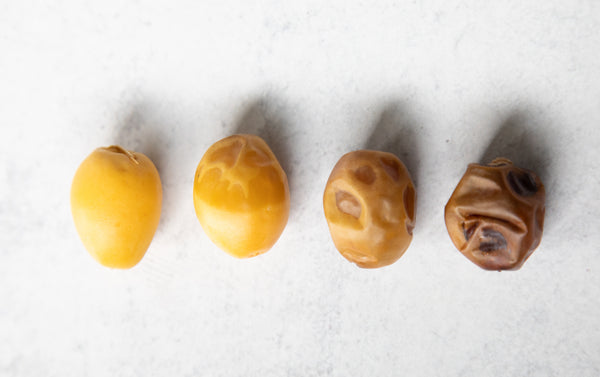The Stages of Barhi Dates
Aug 31, 2021
What is the difference between Yellow Barhi Dates and Brown Barhi Dates? If you are familiar with our website, you may have already read our blog, “All About Yellow Barhi Dates” where we explain exactly what Yellow Barhi Dates are, what they taste like, and all of their health benefits. Today we want to explain the difference between the Yellow Barhi Date and the Brown Barhi Date and what makes this date so special!
Believe it or not, Yellow Barhi Dates and Brown Barhi Dates are actually the same type of date! The only difference between the two is the stage of ripeness that they are at. The reason that Yellow Barhi Dates are so limited and rare is that they are more fresh and ripe than the Brown Barhi Date. With increased moisture level, comes a shorter shelf life which makes Yellow Barhi Dates only available when they are picked fresh off the vine during their harvest season which is late summer/early fall (August/September). Barhi Dates are one of the few varieties of dates that can be eaten at their Khalal stage of ripeness which makes Yellow Barhi Dates a luxury that is hard to come by.
Every date goes through five main stages of growth throughout their lifetime. The first stage is called Hababauk, which is where the female flower is first pollinated and the date is still a small seed. The second stage is the Kimri stage which is the first 17 weeks after pollination. During this stage, the dates are green, hard, and very bitter. They also have the highest acidity and the highest moisture content (80% moisture). Many farmers will remove 60-70% of the fruit from the palm during this time in order to allow the dates left on the tree to get the most amount of nutrients and grow even larger!
The next stage is the Khalal stage which is the stage when Yellow Barhi is harvested! This is why Yellow Barhi Dates are also known as Khalal Barhi Dates! At this stage, they become yellow and the sugar content begins to increase. They have a high moisture content and are still hard which gives them the crunchy apple-like texture when you bite into them.
After the Khalal stage is the Rutab stage where the yellow color begins to fade to brown in an ombre fashion. They begin to lose their moisture content which makes them softer and sweeter. Dates in this stage are also known as “wet dates” because they are very juicy, tender, and delicate.
The Tamar stage, which is the final stage, is the stage that most people are used to seeing when they think of a date. During this stage, the dates have the lowest moisture content which gives them a naturally dried, wrinkled appearance. They have the highest sugar content which makes them sweet, delicious, and a terrific natural substitute for processed sugar!
While the Yellow Barhi Dates and the Brown Barhi Dates are the same date, they each have their own unique flavor and texture. Visit our online shop by clicking here and try both the Yellow Barhi Dates and Brown Barhi Dates for yourself!


